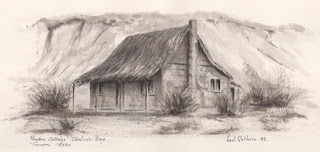Legend of the Poua-kai
 |
| Legend of the Poua-kai |
Moa hunters in New Zealand thought to be early Maori, somewhere between six hundred and one thousand years ago, may possibly lay claim as being among the first to occupy land between the Rangitata and Rakaia Rivers.
In 1869, at the conclusion of an excavation in part of the Rakaia River flats, German geologist and Canterbury Museum
However, Canon J.W. Stack, in his documentation of the district, used the name Waitaha, for tribal people occupying the area from the thirteenth century to the fifteenth.
From the fifteenth century, through to the sixteenth he used the name, Ngati-Mamoe, later, the name Ngai Tahu was used, which has continued until the present day.
According to early historians, there is little evidence to show Ashburton County
From the south, parties came from Arowhenua, following the Opuha and Forest Creek Rivers
After the extinction of the Moa, a favourite delicacy for Maori was the Weka (wood hen). During April, a season when the Weka was plump, parties set out to slaughter and preserve these birds in great numbers. After being snared, birds were plucked, slit open and roasted over an open fire, where their fat flowed, generally into a trough fashioned from wood. Encased in their own molten fat, birds were stuffed into bags fashioned out of split bull-kelp seaweed and perfectly preserved for later use. A process thought to have been used by the Moa-hunters.
A few interesting place names, they say these were established by Maori along their early routes into the Ashburton Gorge.
The Maori translation for Clent Hills appears to have been, Uhi. The Stour River Ashburton River was known to Maori as Hakatere; Lake Heron Lake Tripp Lake Acland Rangitata River
Like other cultures throughout history, Maori have held dear to their hearts the mythical, but tender tales of love and endurance. Tales of forests enshrouded in ghostly mist, of monsters and creatures in the night.
Many Gods were to be appeased in times of war or crisis, as well as enchanted logs and stones which contained magical qualities. Natural phenomena were explained by tales of the invention.
Stories of the moon, the sun and the stars, mountains, rivers, lakes and forests, along with the wind and the weather, were all given character names.
According to Maori legend __ Aotearoa was the home of that great bird, the Moa (poua-kai), which according to Maori, roamed the plains and foothills of Canterbury . The great bird of the land was hunted for food until it became extinct.
According to another legend, the Poua-kai lived at the summit of Mount Tawera , in the Torlesse Ranges , just to the north of the Rakaia River
High on its craggy perch, the Poua-kai kept its constant vigil, preying on people of the Plains.
Spreading its giant wigs at the sight of travellers, it swooped down carrying those hapless victims back to its nest, devouring them at its leisure.
Ruru, a noted bird hunter, was chosen for an expedition against that man-eating bird. Choosing fifty men to accompany him, he ventured into the mountains. Once there he directed his warriors to cut manuka poles, which were then carried to a pool at the bottom of the mountain? Ruru laced the poles together, forming a net across the water.
As Maori warriors crouched beneath their net of manuka, Ruru lured the Poua-kai into his trap. As the giant birds' legs became entangled in the wooden net, warriors grabbed the bird, dragging into the water they killed it.


Comments
Post a Comment